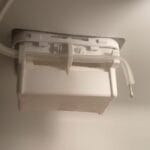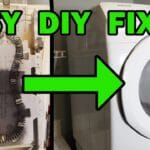Imagine this: You’re wrapping up a relaxing shower, ready to step out, when you turn the faucet handle… And it just keeps dripping. Or worse, water continues to flow as if the handle had a mind of its own.
Frustrating, right? A shower faucet that won’t turn off all the way isn’t just an annoying inconvenience; it can also mean higher water bills and potential water damage over time. But before you start worrying about expensive plumber visits or massive repairs, take a deep breath.
You’ve landed in the right place. You’ll discover simple troubleshooting steps and solutions to fix that stubborn faucet. So, let’s dive in and get your shower back to normal, saving you time, money, and a lot of frustration.
Common Causes
Have you ever faced the frustration of a shower faucet that just won’t turn off all the way? It’s a common issue that many homeowners encounter, leading to wasted water and increased utility bills. Understanding the common causes can help you resolve this problem effectively. Let’s dive into some of the main reasons why your shower faucet might be giving you trouble.
Worn Out Washers
One of the simplest explanations could be worn out washers. Over time, washers can deteriorate, especially in older faucets. Picture this: you’re stepping out of the shower, but the drip-drip-drip continues, echoing through the bathroom. Replacing these small yet crucial components might be all you need to ensure a tight seal and stop the drip.
Faulty Valve Cartridge
Another culprit could be a faulty valve cartridge. If your shower faucet isn’t turning off completely, it might be due to a worn or damaged valve cartridge. This is the part that regulates the flow of water. Think of it like the heart of your faucet. If it’s not functioning properly, the water will keep flowing. Replacing the cartridge can often resolve the issue.
Mineral Buildup
Mineral buildup is another common cause that can interfere with the faucet’s ability to shut off completely. Hard water deposits can clog your faucet, making it difficult to get a snug fit when you turn it off. Imagine brushing your teeth with a clogged tap—frustrating, right? Regular cleaning and maintenance can prevent this buildup and keep your faucet working smoothly.
Improper Installation
Improper installation can also be a reason for a faucet that won’t turn off. If the faucet wasn’t installed correctly, it might not align properly, causing leaks. Reflect on the last time you tried a DIY project and it didn’t quite go as planned. Sometimes, professional installation is worth considering to avoid these issues and ensure everything fits perfectly.
Have you tried fixing a faucet before? Or maybe you’ve experienced one of these issues firsthand? Your insights could help others facing the same dilemma. Share your thoughts or experiences in the comments below.
Tools Needed
Fixing a shower faucet that won’t fully turn off requires basic tools. A wrench, screwdriver, and plumber’s tape are essential. These tools help tighten connections and replace faulty components, ensuring the faucet functions properly again.
Dealing with a shower faucet that won’t turn off completely can be a frustrating experience. Before you dive into the repair process, it’s crucial to gather the right tools. Having the correct tools not only makes the job smoother but also saves you time and effort. You might wonder, what do you need to tackle this plumbing issue effectively?Basic Plumbing Tools
First, let’s talk about basic plumbing tools. You’ll need a wrench, specifically a pipe wrench or an adjustable wrench. These are essential for loosening and tightening nuts and bolts. A screwdriver set is also necessary, as many shower faucets have screws that need removing. A plunger might not be the first tool you think of, but it can be handy for creating pressure and dislodging blockages that might be affecting the faucet. Have you ever tried using a plunger on a stubborn faucet? It can surprisingly work wonders!Replacement Parts
Sometimes, the issue lies in worn-out parts that need replacing. You’ll want to have new washers and o-rings on hand, as these are common culprits when a faucet won’t shut off properly. Consider getting a replacement cartridge, especially if your shower system is older. If you’ve ever replaced a cartridge, you’ll know it can completely restore the functionality of your faucet.Cleaning Supplies
Cleaning supplies are vital, not just for tidying up post-repair. Calcium deposits and grime can cause faucets to malfunction. Vinegar is a powerful cleaning agent that dissolves mineral buildup. A toothbrush or scrub brush can help you reach into nooks and crannies of the faucet, ensuring a thorough clean. Have you ever noticed how much smoother a faucet operates after a good scrub? By equipping yourself with these tools, you’re setting the stage for a successful repair. Are you ready to tackle your faucet issues head-on?Step-by-step Guide
Facing trouble with your shower faucet that won’t turn off completely? Our step-by-step guide helps you fix it easily. Follow simple instructions to regain control over your water flow and prevent leaks.
Having a shower faucet that won’t turn off completely can be frustrating and wasteful. But don’t worry, you can tackle this issue with a little patience and some basic tools. This step-by-step guide will walk you through the process of fixing your faucet, ensuring you save water and avoid costly plumbing bills. Let’s dive into the details and get that pesky faucet under control.Turning Off Water Supply
Before you start, it’s crucial to turn off the water supply to your shower. Locate the shut-off valve in your home. It’s often found near the water heater or under the sink. Turn it clockwise to stop the water flow. If you can’t find a dedicated valve for the shower, you may need to turn off the main water supply. This will stop water throughout your home, so plan accordingly.Disassembling The Faucet
Begin by removing the faucet handle. This usually involves unscrewing a small screw hidden under a cap or the handle itself. Use a screwdriver to gently pry off any covers. Once the handle is off, you’ll see the faucet stem or cartridge. Carefully remove it, noting how it fits together. Consider taking photos as you go to remember the assembly order.Inspecting And Cleaning Components
Take a close look at the removed parts. You might find mineral deposits or grime affecting the faucet’s functionality. Use white vinegar and a brush to clean these components. Check for any worn-out washers, O-rings, or seals. These small parts can often cause leaks or incomplete shut-offs. Cleaning or replacing them might solve the problem.Replacing Faulty Parts
If cleaning doesn’t fix the issue, you may need to replace certain parts. Take the old parts to a hardware store to find exact matches. When replacing, ensure the new components fit snugly and are compatible with your faucet model. This prevents further leaks and ensures a proper seal.Reassembling The Faucet
With all components cleaned or replaced, it’s time to put everything back together. Follow your photos or notes to ensure each piece goes back correctly. Once reassembled, turn the water supply back on. Check for any leaks and test the faucet to ensure it turns off completely. Wasn’t that simpler than expected? Fixing a shower faucet yourself not only saves money but also gives you a sense of accomplishment. Plus, you’ll have a newfound confidence to tackle other minor plumbing tasks. So, what’s your next DIY project?
Credit: www.reddit.com
Preventive Measures
A dripping shower faucet can waste water and increase bills. Regularly check and tighten connections to prevent leaks. Replace worn-out washers or seals promptly to ensure the faucet turns off completely.
A shower faucet that won’t turn off completely can be frustrating and costly. But by taking a few preventive measures, you can avoid this issue altogether. It’s not just about saving water; it’s about peace of mind and protecting your home.Regular Maintenance
Regular maintenance is key to keeping your shower faucet in good working condition. Check for leaks or drips every few months. Replace worn-out washers and seals promptly to prevent bigger problems. Simple tasks like cleaning mineral deposits can extend your faucet’s life. Use a mixture of vinegar and water to remove buildup around the faucet. This ensures smoother operation and prevents stiffness. Consider creating a maintenance checklist. Wouldn’t it be easier to remember when you last checked your faucet if you had a schedule?Using Water Softeners
Hard water is a common culprit for faucet issues. Installing a water softener can reduce mineral buildup in your plumbing. Water softeners help in keeping fixtures cleaner and extend their lifespan. They also make maintenance easier, saving you time and effort. Imagine not having to scrub hard deposits every month. Wouldn’t a water softener be a worthwhile investment?Proper Installation Techniques
Proper installation plays a crucial role in preventing faucet issues. Ensure that your faucet is installed according to the manufacturer’s instructions. Using the right tools and techniques during installation can prevent damage. A well-installed faucet is less likely to have problems down the road. If you’re not confident in your plumbing skills, consider hiring a professional. How much is your peace of mind worth?When To Call A Professional
A stubborn shower faucet that won’t shut off completely signals time to consult an expert. Persistent leaks might lead to higher water bills and potential damage. Prompt professional attention ensures efficient repair and prevents further complications.
A shower faucet that won’t turn off can be frustrating. Sometimes, a simple fix won’t do. Knowing when to call a professional can save you time and money. Experts handle complex issues that need specialized knowledge. Here are situations where professional help is necessary.Complex Repairs
Sometimes, faucet issues are more than a loose handle. They may involve intricate parts or hidden problems. A professional has the right tools and expertise for these repairs. Attempting it yourself might worsen the problem.Persistent Issues
Does your faucet problem keep coming back? Persistent issues might signal deeper plumbing problems. A professional can diagnose the root cause. They ensure a lasting solution, saving you from repeated frustrations.Major Plumbing Overhauls
Old plumbing systems might need a complete overhaul. This is beyond a simple DIY task. A professional can assess the entire system. They provide insights into necessary upgrades. It’s essential for long-term safety and efficiency. `
Credit: alphabuildinginspections.com
Cost Considerations
When your shower faucet refuses to shut off, costs can quickly add up. Understanding these costs helps in deciding the best action. Whether it’s a quick DIY fix or calling a professional, each option has its own expenses. Knowing the cost of replacement parts and potential long-term savings can guide your decision.
Diy Vs Professional Repair
Repairing the faucet yourself can be cost-effective. You might only need basic tools and a few spare parts. A professional repair can be pricier, often charging for labor and materials. While DIY saves money, it requires time and effort. A professional ensures the job is done right, avoiding future issues.
Cost Of Replacement Parts
Replacement parts vary in price. Simple rubber washers are cheap. Full valve cartridges can be more expensive. Prices depend on the brand and model of your faucet. Buying parts from a local hardware store can save on shipping costs. Always compare prices to get the best deal.
Long-term Savings
Fixing your faucet promptly prevents water waste. This leads to lower water bills. A well-maintained faucet lasts longer, reducing future repair costs. Investing in quality parts might cost more initially. But it ensures fewer problems over time, saving money in the long run.

Credit: www.reddit.com
Frequently Asked Questions
Why Won’t My Shower Faucet Turn Off Completely?
A worn-out washer or damaged valve can cause the faucet to stay open. Check for leaks.
How Can I Fix A Stuck Shower Faucet?
Turn off the water supply. Remove the handle. Replace any faulty parts. Test the faucet.
Can A Leaky Shower Faucet Increase Water Bills?
Yes. A leaking faucet wastes water, leading to higher bills. Fix leaks promptly to save money.
What Tools Do I Need To Repair A Shower Faucet?
You may need a screwdriver, wrench, and replacement parts. Read instructions for specific tools needed.
Should I Hire A Plumber For A Broken Faucet?
If you’re unsure or uncomfortable, hiring a plumber ensures proper repair. It can prevent further damage.
Conclusion
Fixing a shower faucet that won’t turn off can be simple. Start by checking the valve. Sometimes debris blocks it. Clean it thoroughly. If that doesn’t work, replace the washer. They wear out over time. Still facing issues? Consider the cartridge.
It might need replacing. Seek professional help if needed. Prevention is key. Regular maintenance saves hassle. Keep an eye on minor leaks. They can become big problems. Understanding your shower’s parts helps. It empowers you to troubleshoot. No need to stress.
Most fixes are straightforward. Enjoy a leak-free shower soon!




